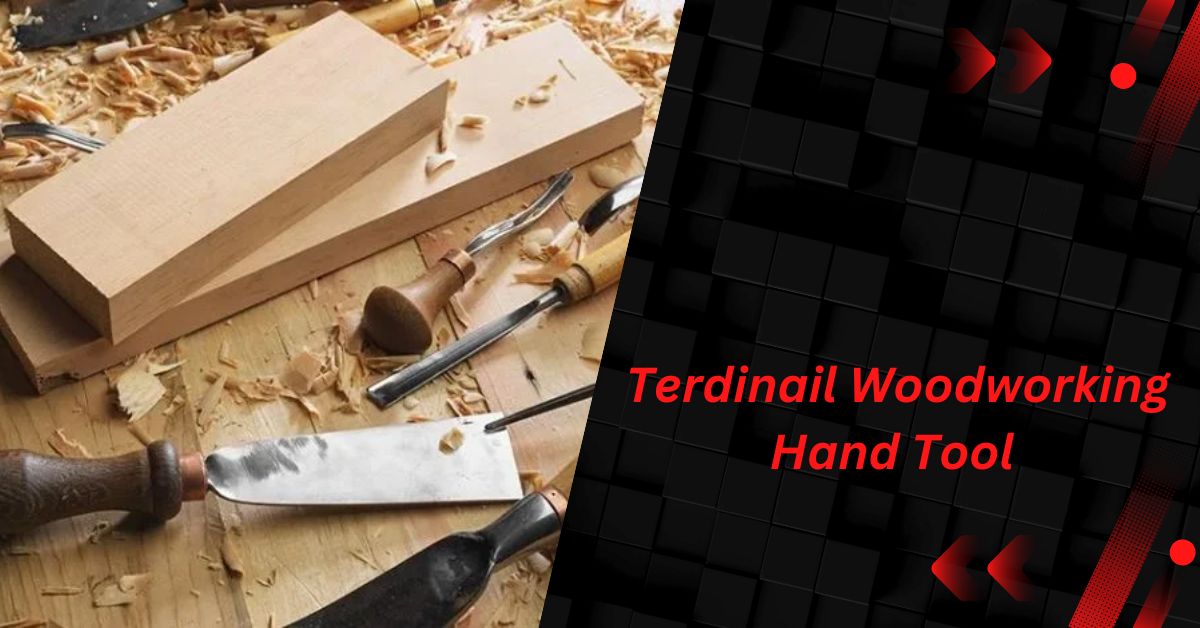Terdinail Woodworking Hand Tool – Mastering the Art of Shaving Removal!
In the world of woodworking, the right tool can make all the difference between a rough, uneven surface and a smooth, polished finish. One such essential tool that has stood the test of time is the terdinail woodworking hand tool used to remove shavings.
This unique instrument bridges centuries of tradition with modern craftsmanship, offering woodworkers of all skill levels the precision and grace needed to achieve flawless results.
In this article, we’ll delve deep into the history, functionality, and usage of the terdinail, exploring how it has evolved, why it remains indispensable, and how you can master it in your woodworking projects.
What is a Terdinail Woodworking Hand Tool?
The terdinail is a specialized woodworking hand tool used primarily to remove thin shavings of wood from a workpiece. Unlike other woodworking tools that cut or chisel, the terdinail is designed to shave, allowing for a more controlled and precise removal of material. This makes it ideal for fine finishing work, such as smoothing surfaces, shaping edges, and achieving the desired thickness.
Key Features of the Terdinail:
- Blade: The terdinail features a sharp, finely honed blade, often adjustable, to control the depth of the shave.
- Handle: Ergonomically designed for comfort during extended use, allowing the user to apply consistent pressure.
- Body: Typically made of durable materials like high-quality steel or wood, ensuring longevity and reliability.
- Adjustment Mechanism: Some terdinails include a mechanism to adjust the blade angle or depth, offering flexibility for different types of work.
History and Evolution of the Terdinail
The terdinail woodworking hand tool has its roots in ancient woodworking traditions. Historically, craftsmen relied on simple tools to shape and refine wood, with the terdinail emerging as a crucial instrument for achieving smooth, even surfaces.
The Early Days:
- Origin: The terdinail’s origins can be traced back to medieval Europe, where woodworkers needed a tool that could delicately remove thin layers of wood without damaging the overall structure.
- Traditional Use: Early versions of the terdinail were handmade, often passed down through generations, and became a symbol of a craftsman’s skill and expertise.
Modern Developments:
- Technological Advancements: With the advent of modern manufacturing techniques, the terdinail has evolved in terms of design and materials, making it more accessible and efficient for today’s woodworkers.
- Continued Relevance: Despite technological advancements, the terdinail remains a favored tool for many artisans due to its simplicity and effectiveness in achieving a refined finish.
How to Use a Terdinail Woodworking Hand Tool to Remove Shavings
Using a terdinail requires skill and patience, but with practice, it can become one of the most rewarding tools in your workshop. Here’s a step-by-step guide on how to effectively use a terdinail:
Step 1: Preparing Your Workpiece
Before you begin, ensure your workpiece is securely clamped to prevent movement during shaving. The surface should be free of debris, as any particles can interfere with the shaving process.
Step 2: Setting Up the Terdinail
- Blade Adjustment: Adjust the blade to the desired depth. A shallower setting is ideal for fine shavings, while a deeper setting can remove more material.
- Handle Grip: Hold the terdinail with a firm grip, positioning your hands on the handle to allow for controlled movement.
Step 3: Shaving Technique
- Angle: Hold the terdinail at a slight angle to the workpiece, ensuring the blade makes full contact with the wood.
- Movement: Push or pull the terdinail along the grain of the wood, applying consistent pressure. Move in smooth, even strokes to achieve uniform shavings.
- Observation: Periodically check the surface to assess your progress. Adjust the blade depth or angle if necessary.
Step 4: Finishing Touches
After removing the desired amount of material, inspect the surface for smoothness. The terdinail should leave a clean, even finish with minimal tool marks. If needed, you can sand the surface lightly to achieve an even finer finish.
The Benefits of Using a Terdinail Woodworking Hand Tool
The terdinail offers several advantages over other woodworking tools, making it an essential part of any woodworker’s toolkit:
- Precision: The terdinail allows for precise control over material removal, essential for detailed work.
- Versatility: Suitable for various woodworking tasks, from rough shaping to fine finishing.
- Ease of Use: While it requires practice, the terdinail is relatively easy to master, making it accessible for beginners and experts alike.
- Quality Finish: The tool’s design ensures a smooth, even surface, reducing the need for extensive sanding.
Common Mistakes and How to Avoid Them
Even experienced woodworkers can make mistakes when using a terdinail. Here are some common pitfalls and tips on how to avoid them:
Mistake 1: Improper Blade Adjustment
- Issue: Setting the blade too deep can cause gouging, while too shallow a setting may result in ineffective shaving.
- Solution: Start with a shallow blade depth and gradually increase as needed. Test on a scrap piece of wood before working on your final project.
Mistake 2: Incorrect Angle of Attack
- Issue: Holding the terdinail at the wrong angle can lead to uneven shavings or damage to the workpiece.
- Solution: Maintain a consistent angle relative to the workpiece, ideally around 45 degrees, to ensure smooth operation.
Mistake 3: Applying Uneven Pressure
- Issue: Uneven pressure can cause the tool to dig into the wood or skip across the surface, leading to an inconsistent finish.
- Solution: Focus on applying consistent, even pressure throughout the stroke. Practice on scrap wood to develop a feel for the correct pressure.
Maintaining Your Terdinail Woodworking Hand Tool
Proper maintenance is crucial to ensuring your terdinail remains effective and lasts for years. Here’s how to keep it in top condition:
Cleaning
- Post-Use Cleaning: After each use, clean the terdinail to remove wood shavings and dust. Use a soft brush or cloth to wipe down the blade and handle.
- Deep Cleaning: Periodically, perform a more thorough cleaning by disassembling the tool (if possible) and cleaning each component individually.
Sharpening the Blade
- Frequency: Regularly check the blade’s sharpness. A dull blade can make shaving difficult and damage the wood.
- Method: Use a sharpening stone or honing guide to maintain the blade’s edge. Sharpen both sides evenly to ensure a straight, sharp edge.
Storage
- Environment: Store the terdinail in a dry, cool place to prevent rust and corrosion. A protective case or cover can help protect the blade.
- Positioning: Store the tool with the blade retracted or covered to avoid accidental damage or injury.
Advanced Techniques for Using a Terdinail Woodworking Hand Tool
Once you’ve mastered the basics, you can explore advanced techniques to expand the versatility of your terdinail:
Curved Surfaces
- Challenge: Shaving curved surfaces requires a steady hand and precise control to maintain even pressure.
- Technique: Adjust the blade depth for lighter shavings and work slowly along the curve. Practice on scrap wood to refine your technique.
Tapered Shavings
- Application: Creating tapered shavings is useful for achieving a gradual reduction in thickness, such as in the construction of furniture legs.
- Method: Gradually adjust the blade depth as you move along the workpiece, starting shallow and increasing depth as needed.
Cross-Grain Shaving
- Difficulty: Shaving across the grain is more challenging due to the increased risk of tear-out.
- Strategy: Use a very sharp blade and take lighter passes. Working at a slight angle to the grain can help reduce tear-out.
The Terdinail in Modern Woodworking
In today’s woodworking world, where power tools dominate, the terdinail continues to hold a special place. Its simplicity and effectiveness make it a go-to tool for tasks that require a delicate touch.
The Rise of Hand Tools in Modern Craftsmanship
- Resurgence: There’s a growing trend among woodworkers to return to traditional hand tools, including the terdinail, to achieve a more authentic and hands-on approach to their craft.
- Sustainability: Hand tools are also favored for their low environmental impact, requiring no electricity and producing minimal waste.
Integrating Terdinails with Power Tools
- Complementary Use: Many woodworkers use terdinails alongside power tools, employing them for tasks that require more precision than power tools can offer.
- Hybrid Approach: This hybrid approach allows for greater versatility in the workshop, combining the speed of power tools with the finesse of hand tools like the terdinail.
Frequently Asked Questions (FAQs)
1. What makes the terdinail different from other woodworking tools?
The terdinail is unique because it shaves wood rather than cutting or chiseling it. This allows for a more controlled and precise removal of material, making it ideal for fine finishing work.
2. Can beginners use a terdinail?
Yes, while the terdinail requires some practice to master, it is accessible to beginners. Starting with shallow shavings on scrap wood can help new users develop the necessary skills.
3. How often should I sharpen the blade of my terdinail?
The frequency of sharpening depends on how often you use the tool and the type of wood you’re working with. Regularly check the blade for sharpness and sharpen it as needed to maintain its effectiveness.
4. Can I use a terdinail on all types of wood?
The terdinail can be used on a wide variety of wood types. However, harder woods may require more frequent sharpening of the blade. Always test on a scrap piece of wood to ensure the tool is set up correctly for the material you’re working with.
5. What is the ideal angle to hold the terdinail?
The ideal angle for holding a terdinail is around 45 degrees to the workpiece. This angle allows for smooth shaving without digging into the wood.
Conclusion
The terdinail woodworking hand tool used to remove shavings is more than just a tool; it’s a bridge between the rich traditions of the past and the innovative craftsmanship of today. Its ability to remove shavings with precision and grace makes it an indispensable asset for woodworkers of all skill levels. Whether you’re smoothing a surface, shaping an edge, or refining a piece to perfection, the terdinail will help you achieve results that are both beautiful and professional.






